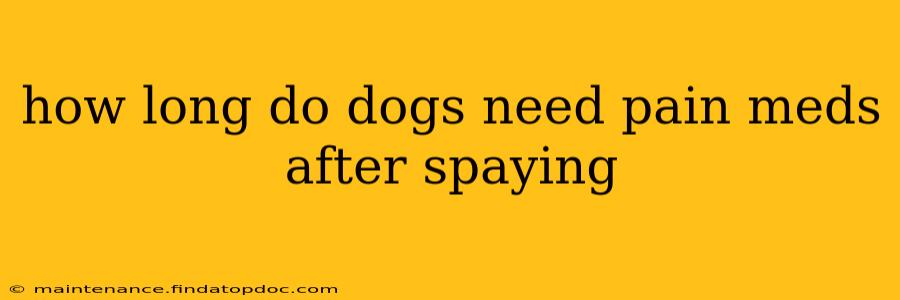Spaying your dog is a significant surgical procedure, and understanding post-operative pain management is crucial for ensuring a smooth recovery. While every dog is different, and the duration of pain medication will vary depending on individual factors, this guide provides a comprehensive overview to help you make informed decisions with your veterinarian.
What is involved in a spay surgery?
Before diving into pain management, it's important to understand the scope of the surgery. Spaying involves removing the ovaries and uterus. This is a relatively invasive procedure, requiring incisions, tissue manipulation, and suturing. The resulting pain can range from mild discomfort to significant soreness, depending on the dog's size, breed, and individual sensitivity.
How long do vets typically prescribe pain medication?
Veterinarians usually prescribe pain medication for 5-7 days following a spay procedure. This timeframe is generally sufficient to manage the initial post-operative pain and inflammation. However, this is just a guideline, and your vet may adjust the duration based on your dog's specific needs and recovery progress.
What are common pain medications prescribed after spaying?
Common pain relievers prescribed for dogs after spaying include:
- NSAIDs (Non-Steroidal Anti-Inflammatory Drugs): These medications, such as carprofen (Rimadyl) or meloxicam (Metacam), are effective in reducing pain and inflammation.
- Opioids: In cases of severe pain, your vet might prescribe a short course of opioid pain medication. These are stronger pain relievers but carry a higher risk of side effects.
It’s crucial to never administer human pain medication to your dog. Human medications can be toxic to dogs, leading to serious health complications. Always follow your veterinarian's instructions meticulously.
When should I contact my vet about my dog's pain?
While some discomfort is expected, it's essential to monitor your dog closely for signs of excessive pain or complications. Contact your vet immediately if you notice any of the following:
- Excessive whining or crying: Constant, high-pitched whimpering suggests significant pain.
- Lethargy or lack of appetite: A significant change in behavior should be investigated.
- Swelling or redness at the incision site: This could indicate an infection.
- Difficulty breathing or restlessness: These symptoms warrant immediate veterinary attention.
- Vomiting or diarrhea: These could be side effects of medication or other complications.
- Licking or chewing at the incision site excessively: This can impede healing.
Can I give my dog more pain medication than prescribed?
Absolutely not. Giving your dog more pain medication than prescribed by your veterinarian can be extremely dangerous and potentially lead to serious complications, including organ damage or even death. Always stick to the prescribed dosage and schedule.
What other factors influence the need for pain medication?
Several factors can influence how long your dog needs pain medication:
- Breed and Size: Larger dogs may require medication for a slightly longer period.
- Individual Pain Tolerance: Some dogs are more sensitive to pain than others.
- Surgical Technique: The surgical approach used can impact post-operative pain levels.
- Complication: Any complications during or after surgery might necessitate a longer course of pain relief.
How can I help my dog manage post-operative pain naturally?
While medication is usually necessary, you can support your dog's recovery with some natural methods:
- Rest: Ensure your dog gets plenty of rest in a quiet and comfortable environment.
- Supportive Care: Avoid strenuous activities and keep your dog calm.
- Nutrition: Encourage your dog to eat nutritious food to support healing.
Remember: this information is for general knowledge and shouldn't replace professional veterinary advice. Always consult your veterinarian for personalized recommendations regarding your dog's post-operative pain management. They will assess your dog's individual needs and determine the most appropriate course of action.
